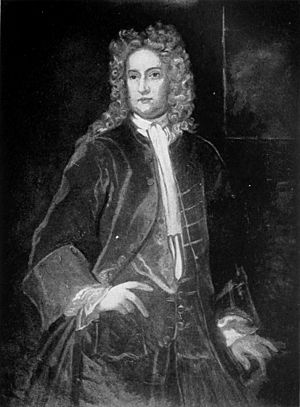William Berkeley (governor) facts for kids
Quick facts for kids
Sir William Berkeley
|
|
|---|---|
 |
|
| Governor of Virginia | |
| In office 1660–1677 |
|
| Appointed by | Charles II |
| Preceded by | Samuel Mathews |
| Succeeded by | Sir Herbert Jeffreys |
| In office 1642–1652 |
|
| Appointed by | Charles I |
| Preceded by | Sir Francis Wyatt |
| Succeeded by | Richard Bennett |
| Personal details | |
| Born | 1605 Hanworth Manor, Middlesex, England |
| Died | 9 July 1677 (aged 71–72) Berkeley House, Mayfair, England |
| Resting place | St Mary's Church, Twickenham Middlesex, England |
| Spouse | Frances Culpeper Stephens Berkeley |
| Residences | Green Spring Plantation, James City County, Virginia |
| Occupation | Planter |
| Signature | |
Sir William Berkeley (born 1605, died 1677) was an important English leader. He served as the governor of Virginia for many years. He was governor from 1642 to 1652 and again from 1660 to 1677.
King Charles I first made him governor. Later, King Charles II brought him back to lead Virginia. Sir William Berkeley was also one of the Lords Proprietors of Carolina. This meant he helped manage that colony too. During his time as governor, some of his decisions caused problems. These problems eventually led to a big uprising called Bacon's Rebellion.
Contents
Who Was Sir William Berkeley?
Sir William Berkeley was born in England in 1605. His family was well-known and had invested in the Virginia Company of London. This company helped set up the Virginia colony. Even as a child, William was known for being smart and eager to learn. He studied at Oxford University, like other men in his family.
In 1632, he joined the household of King Charles I. He was part of a group of writers and artists at court. William Berkeley even wrote several plays. One of his plays, The Lost Lady, was performed for the King and Queen. He also became a knight after serving as a soldier.
First Time as Governor of Virginia
Sir William Berkeley became the governor of Virginia in 1641. He took over from Sir Francis Wyatt. His main goal was to help Virginia grow more than just tobacco. He wanted the colony to produce many different crops. He passed laws to encourage this. He also led by example on his own farm.
He built a home called Green Spring House near Jamestown. There, he tried growing various crops. These included corn, wheat, barley, and even silk. He also experimented with fruits like oranges and grapes. He really disliked tobacco, even though it was Virginia's main crop. He worked hard to find the best crops for the colony. His enslaved people, who knew about rice farming from West Africa, helped him grow rice successfully.
Challenges and Changes
During Berkeley's first term, the English Civil War began in England. This was a fight between the King and Parliament. When Parliament won, King Charles I was executed. Berkeley was a strong supporter of the King. He offered a safe place in Virginia for those who supported the King.
Parliament sent ships to Virginia, and Berkeley had to step down as governor. But he was allowed to stay on his own farm. When the monarchy was restored in England, King Charles II made Berkeley governor again in 1660.
Second Time as Governor
Berkeley had clear ideas for Virginia's future. He wanted a diverse economy, not just tobacco. He also believed in free trade with other countries. He wanted the colony to have more control over its own government. He saw the General Assembly in Virginia as a "miniature Parliament."
He was not friendly towards certain religious groups. He helped pass a law to support the Church of England. This law made it hard for other religious groups to preach freely. Berkeley also did not support public education. He thought it could cause problems in society. He felt the same way about printing.
Bacon's Rebellion and Its Aftermath
Berkeley's second term as governor faced major challenges. In 1675, there were many attacks by Native Americans. People felt that Governor Berkeley was too slow to act. This made many colonists lose trust in him.
A man named Nathaniel Bacon led a group of colonists. He was actually Berkeley's wife's nephew. Bacon decided to fight the Native Americans without the governor's permission. Berkeley declared Bacon a rebel. He tried to fix the colonists' complaints.
Bacon and 500 armed men marched into Jamestown. They forced the lawmakers to make Bacon a general. This turned the fight over Native American policy into a power struggle. It was a fight to see who would control Virginia: Bacon or Berkeley.
Berkeley's forces eventually defeated Bacon's rebels. This allowed Berkeley to take back control of Jamestown. When the King in London heard about the rebellion, he sent soldiers to help. But the rebellion ended before they arrived. The fighting stopped in January 1677. A peace treaty with the Native Americans was signed in May 1677. This happened after Berkeley had already returned to England.
Death
Sir William Berkeley died in England on July 9, 1677. He was buried in a church crypt in Twickenham, England. There is a special window there that remembers him and his brother.
Images for kids


